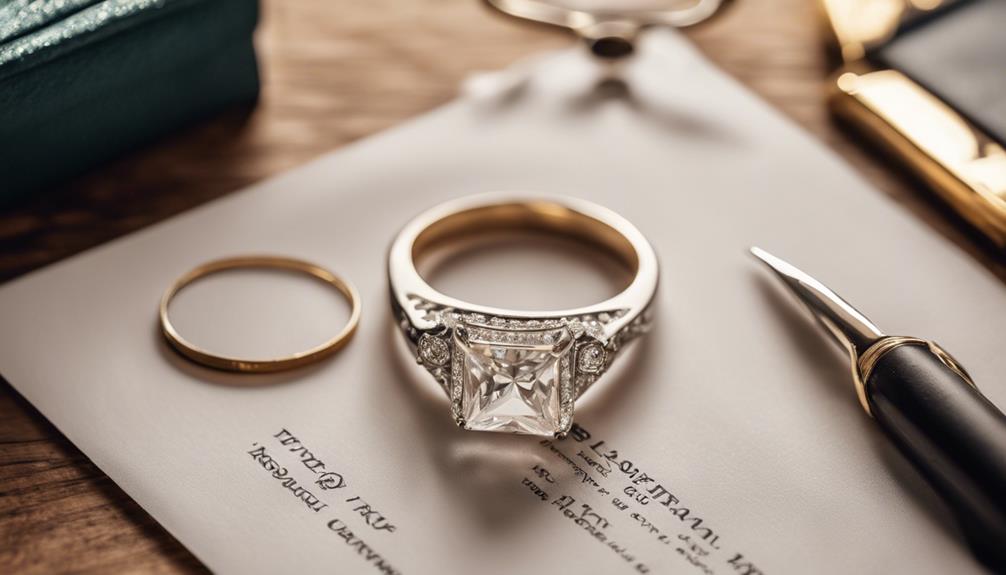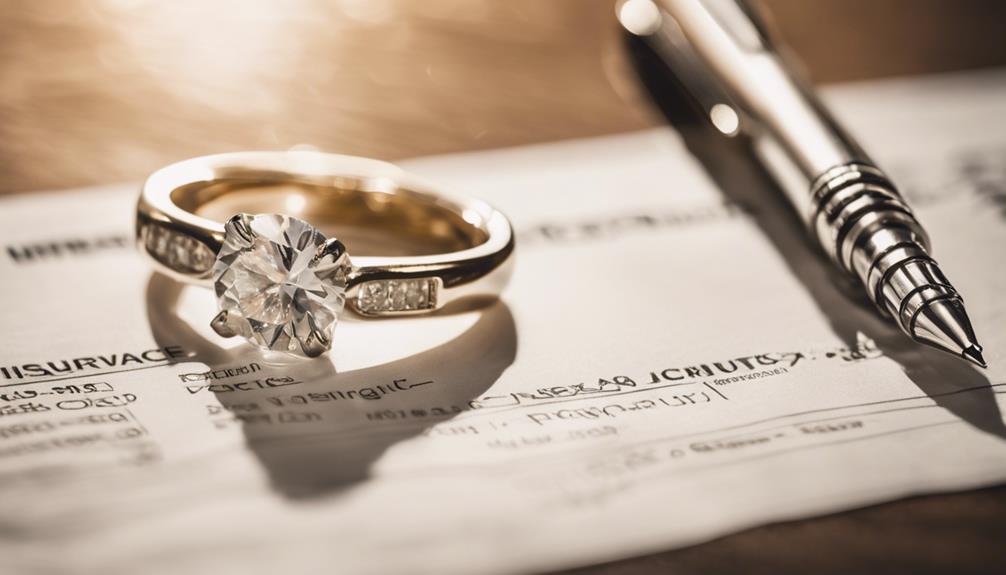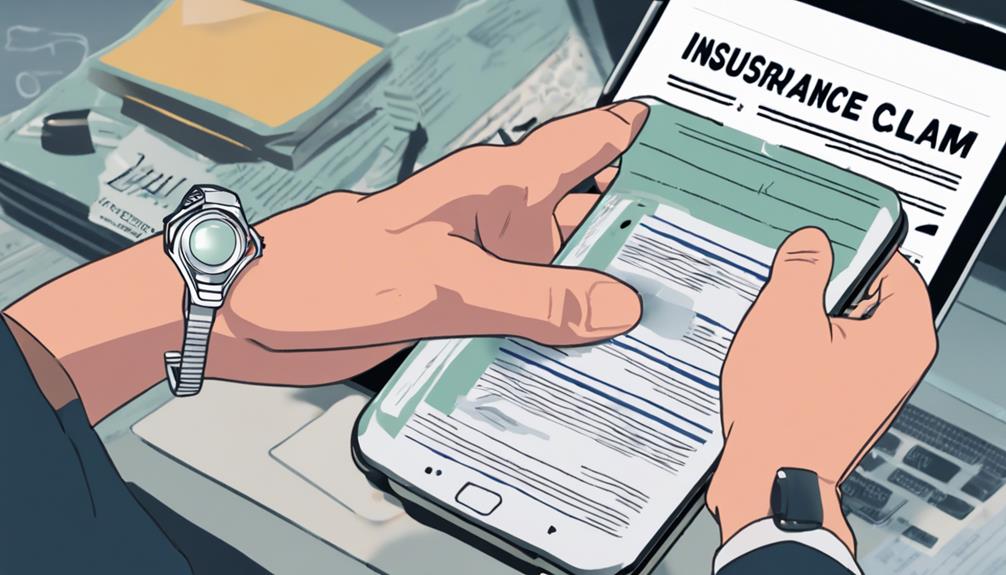Your contents insurance typically covers engagement rings, but the coverage might be limited. Standard policies often cap jewelry coverage between $1,000 and $2,000, which is usually insufficient for high-value rings. To fully protect your ring, you can add a rider to your policy or get stand-alone jewelry insurance. These options provide higher limits and worldwide protection. Remember, insurers usually need an appraisal or receipt to adjust coverage limits. If you want detailed information to guarantee your ring is fully protected, exploring further will provide you with everything you need to know.
Coverage Details for Engagement Rings

When considering contents insurance for your engagement ring, do you know if your policy truly offers sufficient protection? Most standard home insurance policies include some level of jewelry coverage, but it’s often limited, especially for high-value items like engagement rings.
Typically, these policies have a limit for jewelry theft claims, usually around £1,000 to £2,000, which mightn’t cover the full value of your jewelry.
To guarantee your engagement ring is adequately protected, you might need to declare it separately if it’s valued over £1,000. This declaration is vital because it helps the insurer understand the specific value of your jewelry and adjust the coverage accordingly.
One effective option is to add a personal possessions extension to your home insurance policy. This extension broadens the coverage, making sure your engagement ring is protected against loss or damage even when you’re outside the home.
Additionally, you can consider purchasing a scheduled personal property coverage endorsement. This endorsement allows you to increase the coverage limits, ensuring your engagement ring is insured for its full appraised value.
Policy Limits and Sub-Limits
Understanding the policy limits and sub-limits of your contents insurance is vital to guaranteeing your engagement ring is adequately protected. Most contents insurance policies do cover engagement rings, but the standard jewelry coverage often caps between $1,000 and $2,000. This mightn’t be enough if your ring is highly valuable.
Many homeowners insurance policies also impose a theft sublimit for jewelry claims, typically around $1,500. This means if your ring is stolen, you could be left covering a significant portion of the loss out-of-pocket.
To avoid this financial risk, it’s essential to understand these limits and consider the following steps:
- Review Policy Limits: Check your current homeowners insurance policy to understand the maximum coverage for jewelry, including any sublimits for theft.
- Scheduled Personal Property Endorsement: Consider adding this endorsement to increase coverage limits for your engagement ring to its full appraised value. This usually requires a recent appraisal.
- Declare High-Value Items: Guarantee that high-value items like your engagement ring are specifically declared in your insurance policy to avoid any coverage gaps.
Adding a Rider for Full Coverage

If your engagement ring’s value far exceeds the standard coverage limits of your contents insurance, adding a rider is a wise step to secure full protection. A rider allows you to increase the coverage limits specifically for high-value items like engagement rings, guaranteeing they’re covered for their full appraised value.
Standard contents insurance typically caps jewelry coverage between $1,000 to $2,000, which might be insufficient for a valuable ring.
To add a rider, your insurer will usually require documentation such as recent appraisals or receipts detailing the ring’s specifications, including carat weight and value. This documentation helps establish the appraised value of your ring, ensuring you receive adequate coverage.
The cost of adding a rider varies based on the item’s value, but it generally provides more extensive protection against theft, loss, and accidental damage.
Riders typically eliminate the sub-limits that standard policies impose, giving you peace of mind that your engagement ring is fully protected.
It’s essential to review the terms of the rider to understand any exclusions or limitations that may apply to the coverage. This way, you can guarantee your valuable item is thoroughly safeguarded against potential financial loss.
Stand-Alone Jewelry Insurance Options
Stand-alone jewelry insurance offers a tailored solution for protecting your prized engagement ring, guaranteeing it’s covered for its full appraised value. Unlike standard homeowners insurance cover, which often has sub-limits and exclusions, a standalone insurance policy provides more extensive protection. You won’t have to worry about accidental loss, mysterious disappearance, or theft because these jewelry insurance policies typically cover all these scenarios.
Here are three compelling reasons to contemplate stand-alone jewelry insurance:
- Full Value Coverage: Stand-alone policies guarantee your ring is insured for its full appraised value, unlike homeowners insurance, which mightn’t cover the entire cost.
- Separate Claims: Filing claims on your standalone insurance policy won’t impact your homeowners insurance premiums, keeping those costs stable.
- Worldwide Protection: These policies often include worldwide coverage, meaning your ring is protected no matter where you go.
To secure a standalone jewelry insurance policy, you’ll need documentation like receipts or appraisals that detail your ring’s specifications.
While premiums generally range from 1% to 2% of the ring’s value, the peace of mind and extensive coverage provided make it a worthwhile investment.
Filing a Claim for Your Ring

Filing a claim for your engagement ring under contents insurance involves several critical steps to guarantee you receive the compensation you’re entitled to.
First, if theft is involved, report the incident to the police and obtain a copy of the police report for your insurance provider. This documentation is crucial for supporting your claim.
Next, gather all necessary documentation, including photographs, receipts, and appraisals, to demonstrate the ring’s value. This evidence will help substantiate your claim and expedite the process.
Review your policy details to understand any sub-limits that may apply; these sub-limits often range from $1,000 to $2,000 and may not cover the full value of your engagement ring.
When filing a claim for damage rather than loss, check if your policy requires the use of a preferred jeweler for repairs. This detail can affect how and where you get your ring fixed.
Also, be mindful of any deductibles, as these will reduce the amount you receive, making it essential to know exactly what your policy covers.
Conclusion
To summarize, don’t assume your contents insurance fully protects your engagement ring. Standard policies often come with sub-limits and restricted coverage. To safeguard your precious piece, consider adding a rider or opting for a standalone jewelry policy. These steps guarantee you’re not left financially vulnerable. By taking proactive measures, you’ll enjoy peace of mind knowing your cherished engagement ring is well-protected against potential losses. Make informed decisions and secure the coverage you truly need.



